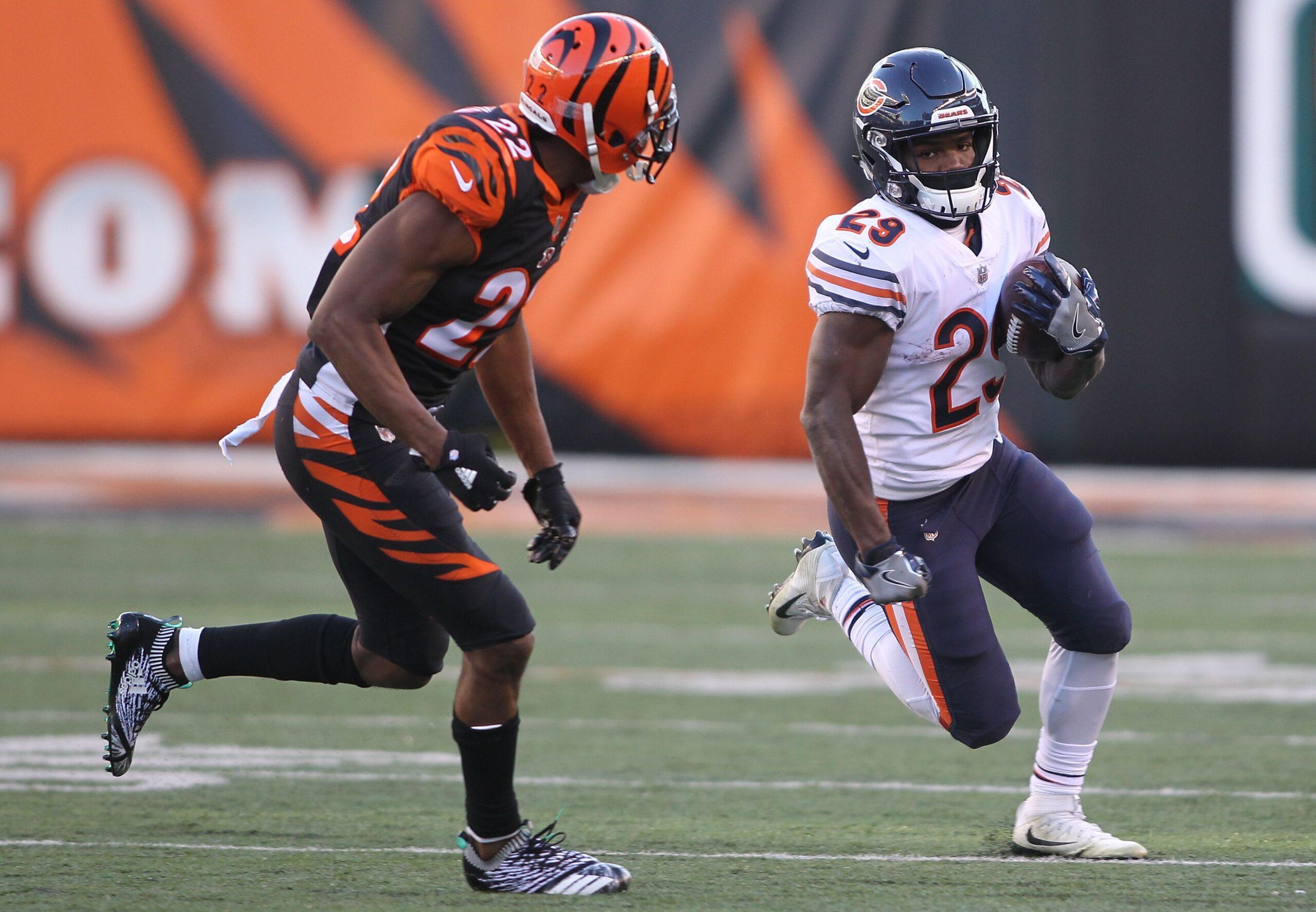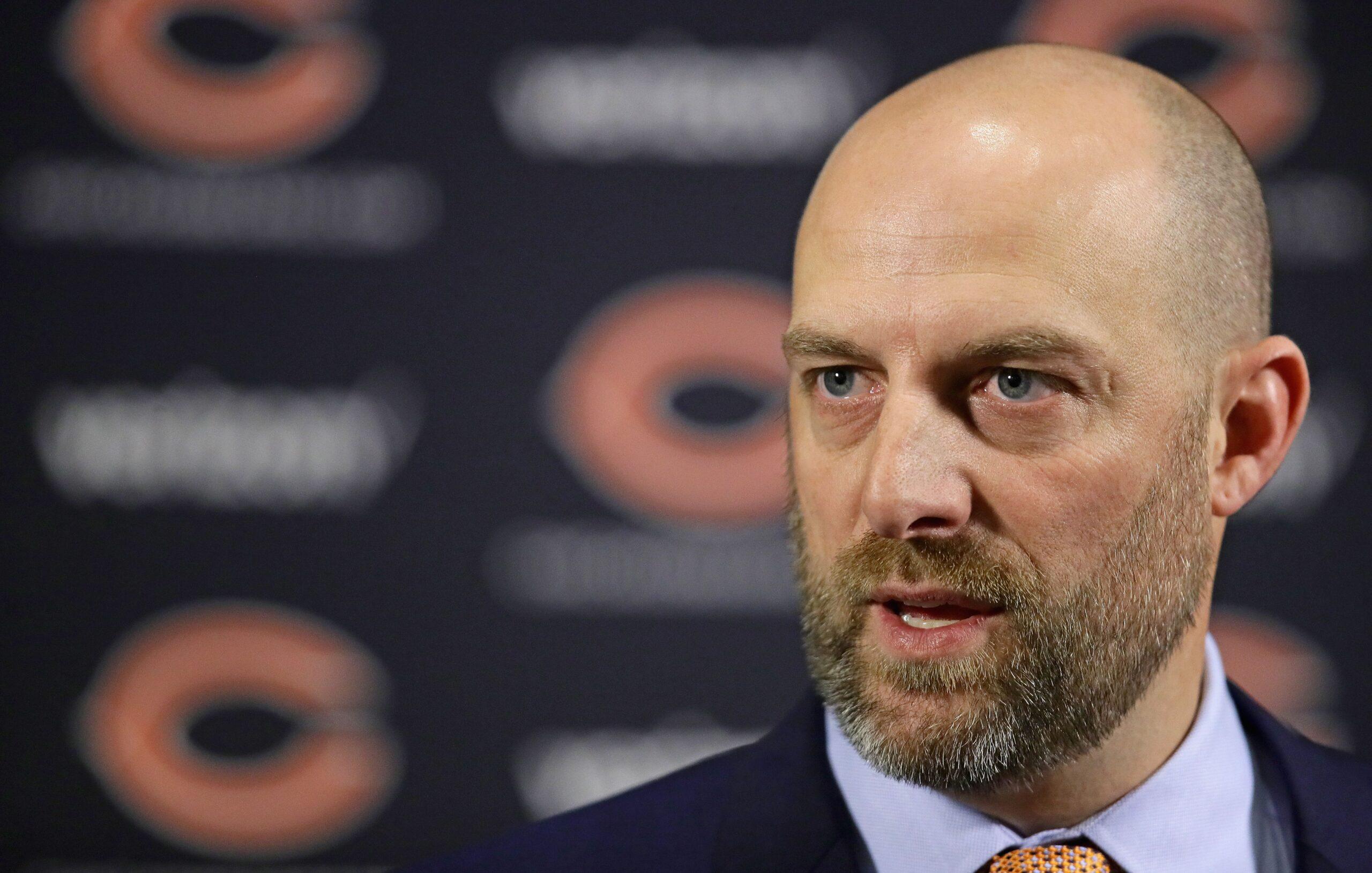When the Bears’ 2018 training camp opened July 21, the surroundings should have been recognizable to anyone who’s made the drive to sleepy Bourbonnais, Illinois. The gift shop is still housed in a small lodge near the entrance. A giant inflatable bear still looms near the closest practice field. The bleachers lining a quiet residential street by Olivet Nazarene University still fill up fast. Most of the environment feels ageless. On the field, though, the product has leapt forward by seemingly decades in time.
Last season Chicago wore its regressive offense as a badge of honor. At times, it felt as if the team’s challenge wasn’t to score, but to win games while scoring as few points as possible. The 2017 Bears became the first NFL team since 1960 to play two games in which they ran fewer than 38 offensive plays. No team in the league averaged fewer yards per drive or went three-and-out more often. Rather than prop up his shiny new rookie quarterback, head coach John Fox turned Mitchell Trubisky into a Milford man—to be neither seen nor heard.
After Fox and his offensive staff were fired in January on the heels of a 5-11 campaign, the franchise set out to rectify the early missteps in Trubisky’s development by replacing Fox with former Chiefs offensive coordinator Matt Nagy. Under Andy Reid, Kansas City deployed one of the most forward-thinking schemes in football in 2017. Players were used in inventive ways that fit their skill sets. Formations, motions, and personnel groupings were used to toy with notions of predictably. Spread concepts born of college football made their way into the Chiefs’ playbook. On the spectrum of ingenuity, the group Nagy piloted as a play-caller late last season was as far from the 2017 Bears as a professional offense could be.
“[The new offense is] going to be a lot like Kansas City,” Chicago backup quarterback Chase Daniel says. “There’s going to be some Oregon stuff in it. It’s going to be a mixed bag. We’re going to be multiple in our formations and our personnel groupings, and we’re to going to blitz the defense.”
It’s a turn for the better. Guys are having fun with it. It feels like a wave of newness, and for the guys who’ve been here, it’s a breath of fresh air.Bears backup quarterback Chase Daniel
Moving from a Fox-inspired offense coordinated by Dowell Loggains to a Nagy-led unit overseen by new coordinator and former University of Oregon head coach Mark Helfrich is a big reason why the Bears may become this season’s version of the 2017 Rams. The parallels between the situations are easy to draw. This year’s Bears are transitioning from a conversative coach to a young, offensive-minded coach whose task is to restore the potential of a prized quarterback prospect. And Chicago would love to replicate Los Angeles’s results: Thanks to head coach Sean McVay’s arrival and an influx of exciting offensive personnel, last year’s Rams underwent the greatest single-season offensive turnaround ever, jumping from 32nd to sixth in Football Outsiders’ DVOA.
There’s a reason Chicago overcorrected in every imaginable way this offseason. Amid all of the familiar aspects of fall camp in Bourbonnais, the offensive transformation is already underway. “You hear that a lot, how it was last year versus this year. It’s a complete 180,” Daniel says. “It’s a turn for the better. Guys are having fun with it. It feels like a wave of newness, and for the guys who’ve been here, it’s a breath of fresh air.”

Asking the Bears to make a leap like the Rams’—from the league’s basement to its elite—downplays just how rare McVay’s impact is. But although his fingerprints were all over the Rams’ miraculous improvement last season, coaching deserves only part of the credit for that turnaround. None of the 2017 offense’s top three receivers—Robert Woods, Sammy Watkins, and Cooper Kupp—were even on L.A.’s roster before March of last year. Tavon Austin, the Rams’ second-most-targeted receiver in 2016, had only 23 passes thrown his way last season. It’s tough to imagine a franchise orchestrating a more wholesale overhaul, but the Bears have somehow managed to do just that.
No receiver on the Chicago’s 2018 roster tallied more than 50 targets for last year’s team. In place of Kendall Wright and injury replacements like Dontrelle Inman is a slew of well-compensated free agents and highly drafted newcomers. Months after scrambling for pass-catching answers, the Bears now have a glut of talented options.
The renovation began with the additions of Allen Robinson and Taylor Gabriel, the highly sought-after free agents Chicago signed in March. Robinson put up sparkling statistics for the Jaguars before tearing his left ACL in Week 1 of last fall and secured a three-year, $42 million contract to take over as the Bears’ no. 1 receiver. Gabriel, meanwhile, inked a four-year, $26 million deal to become the team’s speedy complement to Robinson, giving the Bears a burner who can move both inside and outside depending on the formation. To cap off its flurry of moves, Chicago traded up in the second round of April’s draft to snag Memphis receiver Anthony Miller, who hauled in a combined 33 touchdown passes over his final two college seasons. During most of Fox’s tenure, the Bears planned to lean heavily on 2015 seventh overall pick Kevin White; in 2018, a healthy and productive White would feel like a bonus more than a necessity. “The explosiveness of the people he has around him, it kind of puts [Trubisky] at ease,” Gabriel says. “It relaxes him a little bit and just allows him to trust those throws.”
This shift away from desperation is further accentuated by the rest of Chicago’s pass-catching arsenal. The Bears signed former Eagles tight end Trey Burton this spring, and he’ll fill the Travis Kelce role in Nagy’s offense. Running back Tarik Cohen is a movable, malleable piece who can mimic what Tyreek Hill did for Kansas City. And if Nagy chooses, the Bears should have the option to substitute players almost like a hockey team, bringing in waves of personnel groups to adapt to myriad scenarios.
With the requisite pieces in place, the 2018 Bears should be able to attack defenses with the types of varied formations that the team has long lacked. That’s when the next phase of Chicago’s offensive reinvention begins.

According to Warren Sharp’s 2018 NFL preview, the Chiefs used 12 personnel (two wide receivers, two tight ends, and one running back) on 24 percent of their offensive snaps last season, significantly higher than the league average of 19 percent. Chicago’s offense will likely hover around a similar mark in 2018—and that should allow it to line up its skill-position players in a host of different ways.
Cohen will line up in the slot, as a running back, and out wide. Scenarios featuring him as a receiver will allow both Cohen and running back Jordan Howard to share the field. Burton may be a tight end in title, but he’ll act as a slot receiver most of the time. In some alignments, he’ll be deployed in addition to tight ends Dion Sims and Adam Shaheen, but don’t expect them to all be bunched near the line of scrimmage. Burton’s time in Philadelphia was an ideal precursor to his role in Nagy’s offense, given the Eagles also ran a Reid-born system under former Chiefs coordinator Doug Pederson. He has told his new teammates that understanding how they line up—and why—should be their top priority. “None of the plays matter if you can’t line up,” Burton says. “The formations, the shifts, the motions, if you can learn that, you probably know 80 percent [of the offense]. If you know where you are, based on the concept, you can understand what we’re out to run.”
As the Bears have gone about installing their new offense, teaching players why certain formations and motions are used has been key. That’s where the major difference between this year’s Bears and last year’s version lies. It’s not as if Chicago didn’t use a variety of formations in 2017; the Bears were more formationally diverse than most offenses around the league. They used 11 personnel (one running back, one tight end, three wide receivers) only 53 percent of the time last season, the ninth-lowest rate in football, Sharp reported. The distinction will come in how Nagy plays with the tendencies within those alignments.
When the Bears lined up in 11 personnel last season, they threw 77 percent of the time. In 12 personnel, that dropped to 39 percent. On first down, Chicago ran the ball 55 percent of the time, the sixth-highest mark in the league, according to Football Outsiders. When its quarterbacks were under center, it ran on 74 percent of its plays.
It’s not hard to sense the patterns. Predictable rates set an offense up to fail—and fail the Bears did. “Defenses are so good these days that you can’t just line up and run stuff,” Burton says. “There’s so much talent on the other side of the ball that you have to be extremely creative. When you can have a couple guys together that enjoy talking about football, and also have a creative mind-set, that makes it tougher.”
Conversely, no team did more to manipulate defenses by subverting expectations than the Chiefs in 2017. When using 12 personnel, Kansas City threw 62 percent of the time. In fact, Reid and Nagy often used that heavy, run-first formation to package some of their most aggressive concepts.
Defenses are so good these days that you can’t just line up and run stuff. There’s so much talent on the other side of the ball that you have to be extremely creative.Bears tight end Trey Burton
On two separate plays in the Chiefs’ wild-card round playoff game against the Titans, Nagy used 12 personnel to dial up vertical shots for Kelce. The second instance came late in the first quarter, with Kansas City in the red zone. After motioning tight end Demetrius Harris from right to left, Alex Smith faked a handoff to Kareem Hunt before hitting Kelce up the seam for a touchdown. By lining up in a heavy formation and faking a handoff, the Chiefs caught Tennessee in its base defense, reacting to the type of play most offenses would run out of a two-tight-end set. “It’s a lot of stuff going on,” Daniel says of the motions and fakes. “It’s a lot of stuff in the backfield that the second-level defenders, the linebackers, have their eyes on.”
The Chiefs’ best distraction tool last season was undeniably Tyreek Hill. No matter the endgame, Kansas City sent him scurrying in motion, seeking out ways to relentlessly confuse opposing defenses. As the Bears consider how to maximize Cohen, they’ll undoubtedly keep Hill in mind.
“There’s a jet sweep this way, a handoff that way,” Daniel says. “There’s a quarterback possibly keeping it. There’s a screen off that. There’s guys crossing on a drop back off that. We have the same formation, the same motions and jets, three different ways: a run, a play[-action] pass, and a straight run. That puts a lot of stress on [a linebacker]. That’s what I like best about this offense.”

The last time that Gabriel switched teams was in 2016, when he signed with the Falcons. He arrived in Atlanta to find a ninth-year quarterback entering his second season in an offensive system. Getting used to playing with Matt Ryan required Gabriel to graft his game onto Ryan’s preferences; with the Bears, he’s found a quarterback who’s in the process of having the entire offense imprinted with his DNA. Coming aboard at that stage has facilitated constant communication. “We’re talking after every play,” Gabriel says. “I’m asking what he wants, what he’s seeing against certain coverages.”
We’re continually evolving. That’s why you can never truly know the offense, because we’re always changing it.Trey Burton
With training camp now in full swing, the theoretical has become reality, and that requires on-the-fly adjustments. For this transformation to take hold, dynamic problem-solving is a necessity, and Burton says he’s already seen how quickly Nagy can adjust when concepts hit a snag. “Some teams rough stuff, and they don’t change,” he says. “No matter if the defense stops it, they’re going to continue to run it. Whereas we’re continually evolving. That’s why you can never truly know the offense, because we’re always changing it.”
Most of the material the Bears install is part of a program that Nagy developed with Reid in Kansas City. But sometimes experimenting yields formations or personnel packages that are too tempting to turn down. “There might be some things that Mark and I see out on the field and want to test,” Nagy says. “That’s where the creativity comes. Sometimes things might happen where the offensive coaches have no idea what we’re doing, but we just want to test it.”
Nagy said that he and Helfrich are still “learning each other” and coming to understand their strengths in weaknesses. Together, a coach who spent last season on the forefront of NFL innovation and a coordinator who was forged in the crucible of college football innovation are invigorating a quarterback and offense that both badly needed a jolt. The Bears have done all they can to start anew, and those changes go all the way to the core.
